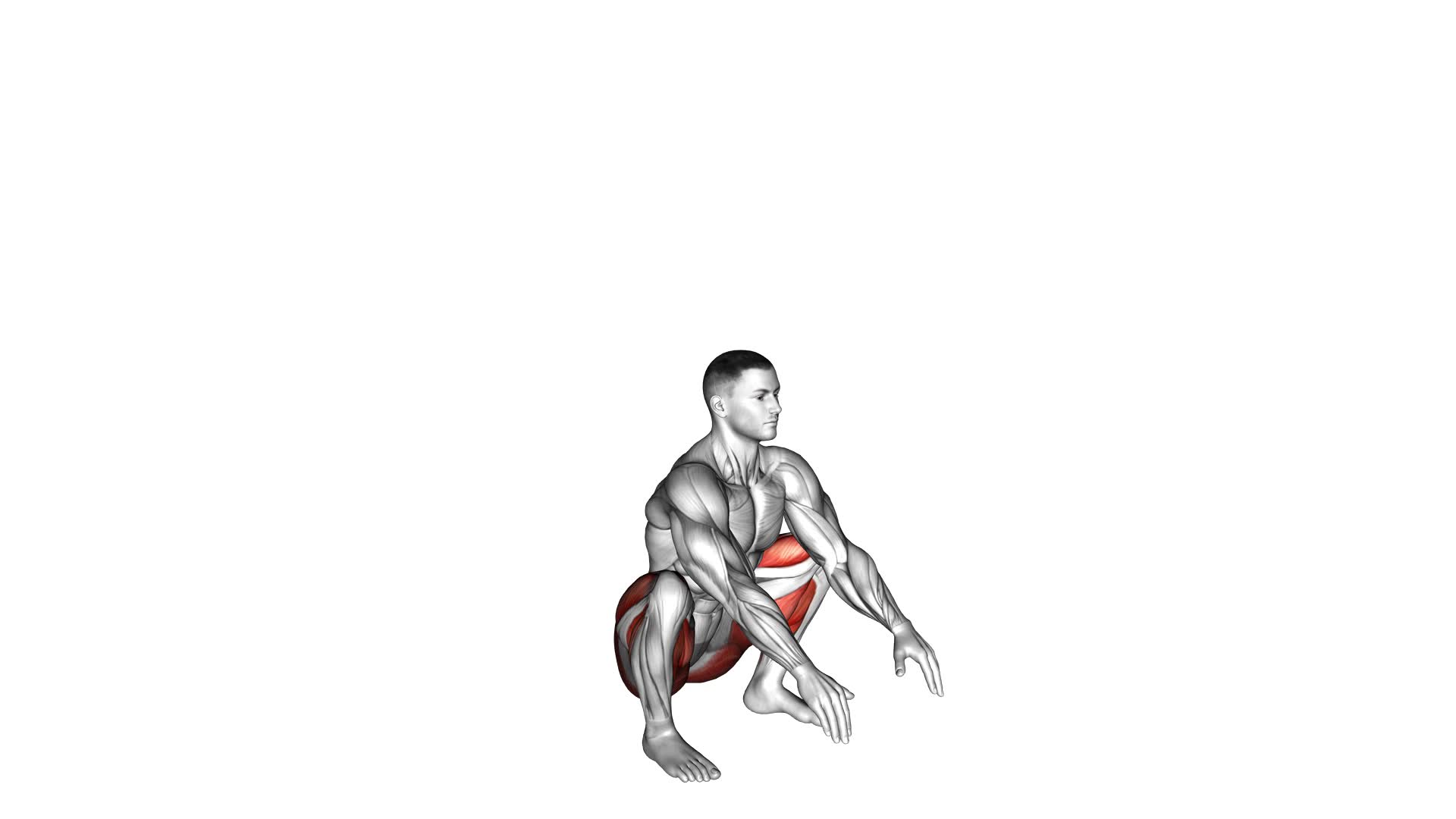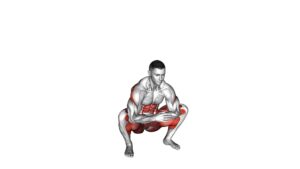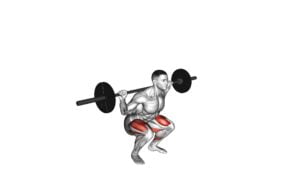Full Squat Mobility – Video Exercise Guide & Tips

Are you looking to improve your squat mobility? Look no further!
Watch This Exercise Video
In this video exercise guide, we will provide you with tips and techniques to help you achieve full squat mobility.
By avoiding common mistakes and incorporating essential warm-up exercises, you'll be able to enhance your flexibility and strength.
Whether you're a beginner or advanced, this guide offers advanced variations to take your mobility to the next level.
Get ready to incorporate full squat mobility into your routine and see the results!
Key Takeaways
- Full squat mobility improves flexibility, range of motion, and hip mobility.
- It engages muscles in the hips, glutes, and thighs, enhancing overall athletic performance.
- Proper form and warm-up exercises are important to avoid common mistakes and reduce the risk of injury.
- Incorporating full squat mobility into your routine can lead to numerous benefits such as improved balance, lower body strength, and calorie burning.
Benefits of Full Squat Mobility
To improve your flexibility and range of motion, incorporating full squat mobility into your exercise routine offers numerous benefits. Full squat mobility exercises target the hips, improving range of motion and hip mobility. By performing full squats, you engage the muscles in your hips, glutes, and thighs, helping to increase their flexibility and strength. This improved mobility can enhance your overall athletic performance and reduce the risk of injury during physical activities.
When you practice full squat mobility exercises, you're actively stretching the muscles and tendons in your hips, which can help to alleviate tightness and discomfort. Additionally, these exercises promote better hip joint stability, which is crucial for maintaining proper alignment and preventing imbalances in the lower body.
Improved hip mobility and range of motion can also have a positive impact on your daily life. It can make activities such as sitting, standing, and walking easier and more comfortable. Moreover, full squat mobility exercises can benefit individuals who participate in sports or activities that require explosive movements, such as jumping or sprinting.
Incorporating full squat mobility exercises into your routine is a great way to improve your overall flexibility and hip mobility. By practicing these exercises regularly, you can enjoy the benefits of increased range of motion, better hip joint stability, and improved performance in your workouts and daily activities.
Now, let's move on to the next section and discuss some common mistakes to avoid when performing full squat mobility exercises.
Common Mistakes to Avoid
When performing full squat mobility exercises, it's important to be aware of common mistakes to avoid. By avoiding these mistakes, you can prevent injuries and improve your range of motion effectively.
Here are some common mistakes to watch out for:
- Not maintaining proper form: It's crucial to maintain proper form throughout the exercise to avoid unnecessary strain on your joints and muscles. Keep your back straight, chest up, and knees in line with your toes.
- Going too low too quickly: While it's important to challenge yourself, going too low too quickly can put excessive stress on your knees and lower back. Progress gradually and listen to your body's limitations.
- Neglecting warm-up exercises: Warm-up exercises help prepare your muscles and joints for the full squat mobility exercises. Skipping warm-up can increase the risk of injuries and reduce your range of motion.
- Using excessive weight: Adding too much weight can compromise your form and increase the risk of injuries. Start with lighter weights and gradually increase as your strength and form improve.
Essential Warm-Up Exercises
Start with dynamic stretching exercises to warm up your muscles and increase blood flow before engaging in full squat mobility exercises. Dynamic stretching involves moving your body through a range of motion to gradually increase flexibility and mobility. It's an essential part of any warm-up routine as it helps prepare your muscles, joints, and tissues for the demands of full squat mobility exercises.
To begin, you can incorporate exercises such as leg swings, arm circles, and hip rotations. Leg swings involve swinging your leg forward and backward or side to side, which helps to loosen up your hip flexors and hamstrings. Arm circles are beneficial for warming up your shoulder joints and increasing blood flow to the upper body. Hip rotations help to lubricate the hip joints and improve mobility.
Additionally, you can include exercises like walking lunges, high knees, and butt kicks. Walking lunges target your quadriceps, glutes, and hip flexors while also engaging your core. High knees and butt kicks are great for warming up your leg muscles and increasing your heart rate.
Advanced Variations for Greater Mobility
To further enhance your mobility, try incorporating advanced variations of full squat exercises into your routine. These advanced modifications are designed to challenge your body and increase your flexibility and strength.
Here are four mobility drills that you can incorporate into your full squat routine:
- Pistol Squats: This exercise involves performing a squat on one leg while keeping the other leg extended in front of you. It requires a great deal of balance and stability, and it targets the muscles in your legs and core.
- Bulgarian Split Squats: This exercise is a more challenging version of the traditional squat. It involves placing one foot on an elevated surface behind you and performing a squat with the other leg. It targets your quads, hamstrings, and glutes, while also improving your balance.
- Overhead Squats: This exercise involves performing a squat while holding a barbell or a weight overhead. It not only improves your leg strength but also challenges your upper body mobility and stability.
- Jump Squats: This exercise adds an explosive element to the squat. It involves performing a squat and then exploding upward into a jump. It helps to improve your power and explosiveness.
Incorporating these advanced variations into your full squat routine will help you to push your limits and continue to improve your mobility and strength. Remember to start with lighter weights and gradually increase the difficulty as your mobility improves.
Tips for Improving Flexibility
To enhance your flexibility, focus on incorporating these tips into your full squat routine.
Improving hip mobility is crucial for enhancing your overall flexibility. One effective way to do this is by incorporating dynamic stretching techniques into your warm-up routine. Dynamic stretches involve moving your body through a full range of motion, which helps to activate and loosen up your muscles. Examples of dynamic stretches for hip mobility include leg swings, hip circles, and walking lunges.
In addition to dynamic stretching, static stretching can also be beneficial for improving flexibility. After your workout, take the time to hold static stretches for the muscles targeted in your full squat routine. This can help to lengthen and relax your muscles, promoting better flexibility over time. Some effective static stretches for hip mobility include the butterfly stretch, pigeon pose, and seated forward fold.
Remember to listen to your body and never force a stretch beyond your comfort level. It's important to gradually increase the intensity and duration of your stretches over time.
Consistency is key when it comes to improving flexibility, so make sure to incorporate these stretching techniques into your full squat routine regularly. By doing so, you'll be well on your way to achieving greater hip mobility and overall flexibility.
Incorporating Full Squat Mobility Into Your Routine
To incorporate full squat mobility into your routine, you can experience the numerous benefits it offers.
By performing full squats, you can improve lower body strength, increase flexibility, and enhance overall mobility.
To ensure proper form, remember to keep your heels on the ground, maintain a straight back, and engage your core throughout the movement.
Benefits of Full Squat
Incorporating full squat mobility into your routine is a great way to enhance flexibility and strength. There are numerous benefits to adding full squats to your workout regimen, which can greatly improve your overall fitness level. Here are four reasons why you should consider adding full squats to your routine:
- Improves balance: Full squats require stability and control, which helps strengthen the muscles that support your balance. This can be especially beneficial for older adults or those with balance issues.
- Increases lower body strength: Full squats target the muscles in your lower body, including your quadriceps, hamstrings, glutes, and calves. By regularly performing full squats, you can increase the strength and power of these muscles, leading to improved athletic performance and functional movements.
- Enhances mobility: Full squats involve a deep range of motion, which can help improve your hip, knee, and ankle flexibility. This increased mobility can translate to better performance in other exercises and daily activities.
- Burns calories: Full squats are a compound exercise that engages multiple muscle groups simultaneously. This means that they can help you burn more calories in a shorter amount of time, making them an efficient addition to any workout routine.
Incorporating full squats into your routine can provide a wide range of benefits, including improved balance, increased lower body strength, enhanced mobility, and calorie burning. So why not give them a try and see the positive impact they can have on your overall fitness?
Proper Form Techniques
Improve your full squat technique by focusing on proper form and incorporating full squat mobility into your routine.
One common misconception about full squats is that they're bad for your knees. However, when done with proper form, full squats can actually strengthen the muscles around the knee and help prevent knee injuries.
To ensure proper form, start by standing with your feet shoulder-width apart, toes pointed slightly outward. As you lower into the squat, keep your chest lifted, back straight, and knees tracking over your toes. Engage your core and push through your heels as you rise back up.
Tips for Increasing Flexibility
To increase your flexibility and incorporate full squat mobility into your routine, focus on gradually deepening your squat and engaging the necessary muscles. Here are some tips to help you in increasing your range of motion and incorporating full squat mobility:
- Warm up properly before attempting any stretching techniques.
- Start by performing bodyweight squats and gradually work your way towards a deeper squat position.
- Engage your core and keep your back straight while squatting to ensure proper form and prevent injuries.
- Incorporate dynamic stretching exercises such as lunges and leg swings to improve your hip and ankle mobility.
Frequently Asked Questions
Can Full Squat Mobility Help With Lower Back Pain?
Full squat mobility can be beneficial for relieving lower back pain. By incorporating full squat mobility techniques into your exercise routine, you can improve your overall flexibility and strengthen the muscles in your lower back. This can help alleviate tension and provide support to your spine, reducing the likelihood of experiencing lower back pain.
Additionally, full squat mobility benefits include improved hip and ankle mobility, which can further contribute to a healthier and pain-free lower back.
How Often Should I Practice Full Squat Mobility Exercises?
To improve your full squat mobility, it's important to practice the exercises regularly. By incorporating full squat mobility exercises into your routine, you can experience the benefits of increased flexibility and strength in your lower body.
To make progress, aim to practice these exercises at least three to four times a week. Consistency is key, so try to find a schedule that works for you and stick to it. Remember, the more you practice, the better your results will be.
Is It Necessary to Have a Certain Level of Fitness Before Attempting Full Squat Mobility Exercises?
Before attempting full squat mobility exercises, it's important to consider your necessary fitness level. These exercises require a certain level of strength, flexibility, and mobility.
However, the benefits of full squat mobility are worth the effort. They improve hip and ankle mobility, increase leg strength, and enhance overall functional movement.
Can Full Squat Mobility Exercises Improve My Balance and Stability?
Full squat mobility exercises can greatly improve your balance and stability. By engaging multiple muscle groups and promoting joint flexibility, these exercises help you develop a strong and stable foundation.
Athletes can benefit from full squat mobility exercises as they enhance their performance and prevent injuries. Similarly, seniors can also benefit from these exercises as they improve overall balance and reduce the risk of falls.
Incorporating full squat mobility exercises into your routine can lead to improved functional movement and overall well-being.
Are There Any Modifications or Alternatives for Individuals With Knee or Hip Issues?
If you have knee or hip issues, there are modifications and alternative exercises available for you. It's important to prioritize your safety and comfort.
For knee issues, you can try partial squats or use a stability ball against a wall for support.
For hip issues, you can perform hip bridges or seated leg press exercises.
Always consult with a healthcare professional or a certified trainer to ensure you're performing the exercises correctly and without aggravating your condition.
Conclusion
Incorporating full squat mobility into your routine can greatly benefit your flexibility and overall mobility.
By avoiding common mistakes and incorporating essential warm-up exercises, you can improve your range of motion and prevent injuries.
Advanced variations can be added for even greater mobility gains.
Remember to focus on proper form and listen to your body's limits.
With consistency and dedication, you can enhance your squat mobility and experience the many benefits it has to offer.

Author
Years ago, the spark of my life’s passion ignited in my mind the moment I stepped into the local gym for the first time. The inaugural bead of perspiration, the initial endeavor, the very first surge of endorphins, and a sense of pride that washed over me post-workout marked the beginning of my deep-seated interest in strength sports, fitness, and sports nutrition. This very curiosity blossomed rapidly into a profound fascination, propelling me to earn a Master’s degree in Physical Education from the Academy of Physical Education in Krakow, followed by a Sports Manager diploma from the Jagiellonian University. My journey of growth led me to gain more specialized qualifications, such as being a certified personal trainer with a focus on sports dietetics, a lifeguard, and an instructor for wellness and corrective gymnastics. Theoretical knowledge paired seamlessly with practical experience, reinforcing my belief that the transformation of individuals under my guidance was also a reflection of my personal growth. This belief holds true even today. Each day, I strive to push the boundaries and explore new realms. These realms gently elevate me to greater heights. The unique combination of passion for my field and the continuous quest for growth fuels my drive to break new ground.



